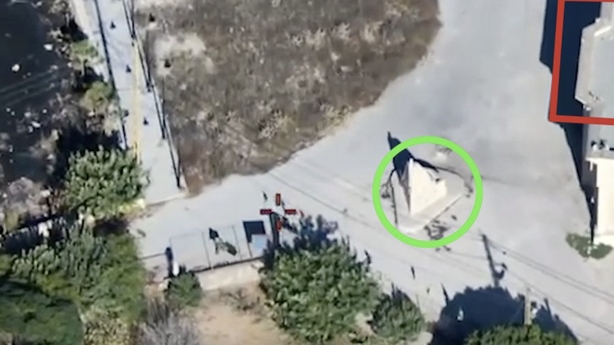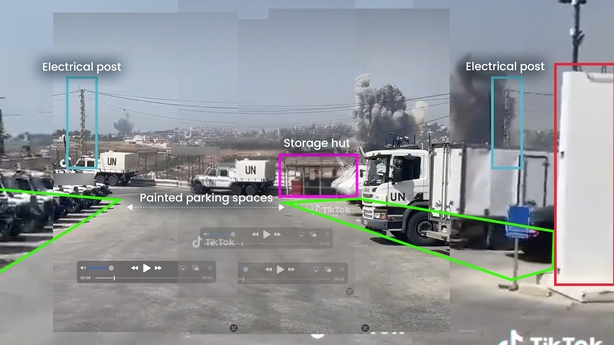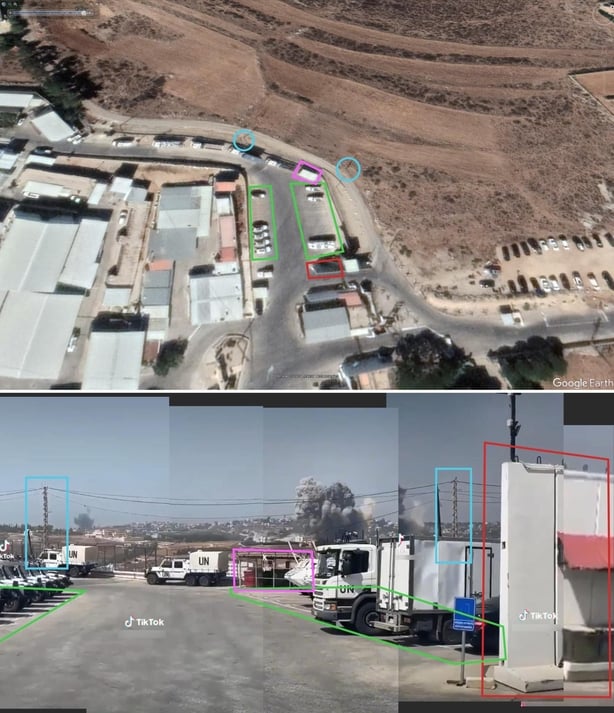As the conflict in Lebanon ramps up, Irish peacekeepers are caught between two warring parties. In the midst of that fighting, a battle for eyes and emotions is raging online, and concerns about misinformation and disinformation are widespread.
The UN mission in Lebanon, UNIFIL, has warned about the spread of false information, and the real-life impact it can have on peacekeepers on the ground.
Families at home are also eager for news about what is happening near their loved ones. Independent journalists have not been able to access the part of southern Lebanon where Irish peacekeepers are located, meaning information is difficult to ascertain.
However, in addition to normal journalistic practices of developing and speaking with sources, newer processes involving monitoring online reports and verifying images and videos released have allowed a picture to be gleaned of what is happening specifically in the Irish UNIFIL Area of Responsibility.
RTÉ has confirmed that since Israel's incursion into southern Lebanon on 1 October, there have been dozens of airstrikes and artillery barrages by the IDF in the Irish UNIFIL zone. Hezbollah has claimed tens of attacks.
That is a far from a conclusive picture of the military activity which has been on-going in the Irish area, but shows the scale of fighting which has even been possible to document.
Strikes and attacks have been mapped, to see where they occurred in relation to the locations of Irish peacekeepers. Similarly, any available footage from the ground has been analysed for indicators of the locations of fighters and troops.
In many cases the incidents can be pinpointed precisely based on statements, footage, or imagery released by one or both of the warring parties, and compared to commercially available satellite imagery.
How it is done: Monitoring & Verification
While Hezbollah often mentions specific villages in their statements about attacks or clashes, the IDF usually only refers to "southern Lebanon."
However, the IDF often mentions certain brigades or units. By monitoring Hezbollah statements for locations, and IDF updates and released imagery for badges, units and iconography, it has been possible to build up a picture of activity, and which IDF units are operating within the Irish zone.
Read more: The Irish UNIFIL Zone: What we know about recent clashes
When combined with monitoring of local and regional media for mentions of specific locations, and setting alerts for mentions of certain words in Arabic or Hebrew, it is possible to get some understanding of the extent of the incursion and locations of ground fighting in the Irish UNIFIL zone.
The IDF releases video and imagery from Lebanon several times a day. There have been dozens of such images released from "southern Lebanon" which have been subsequently confirmed by visual analysis to have been taken in locations within the Irish UNIFIL zone.
For example, on 9 October the IDF released footage on Telegram from a military drone. It was tracking an individual said to be a Hezbollah fighter moving along a street and behind tree lines. An air strike on a building followed, with the IDF saying the person shown had been killed.
WATCH: Footage uploaded by Israel Defence Forces to Telegram on 9 October
(Note: This footage is published in the same form and duration as released by the IDF)
The release did not name the area where the strike took place, but referenced the Golani Brigade, which is known to be one of the IDF brigades operating in the Irish UNIFIL zone.
At the time, based on previous updates from the IDF and Hezbollah, it was known that the Golani Brigade was operating around Maroun El-Ras, the town nearest the Irish UNIFIL outpost 6-52.
The footage showed a pyramid-shaped monument, and a building with a roof with an unusual edge profile.

By examining satellite imagery of the town of Maroun El-Ras for locations and buildings matching those characteristics, it was possible to pinpoint the exact location where the footage was taken, and where the strike hit.
This confirmed there had been recent IDF engagements on the northern edge of the town, 1.5km from Irish peacekeepers.
When combined with other information about further confirmed engagements, it indicated fighting at the time had been moving northwards.

Similar techniques can also be used to clarify misinformation or debunk claims being circulated online about activities, including those linked to the Irish UNIFIL zone.
#CampShamrock' video circulated
Early last week a video was circulated across social media. It first appeared on TikTok, from where it was soon deleted. Within hours it had been viewed over 1.5 million times on X alone.
The original poster captioned the video '#CampShamrock’, the name of the main Irish UN base in Lebanon.
RTÉ is posting a version below with audio removed. In the original video post, people with Irish accents could be clearly heard speaking in the background, as air strikes landed on locations in areas nearby.
WATCH: Footage social media users said was from inside Camp Shamrock, or UNP 6-52
(RTÉ has muted and blurred the footage to avoid identification of individuals)
As the video was circulating across social media, 30 Irish peacekeepers were in outpost 6-52 on the blue line between Israel and southern Lebanon.
Israeli tanks and other units were firing from metres away, towards Hezbollah. The proximity of the IDF forces to the Irish UN troops was a major international news story.
On TV and radio programming, discussions were being regularly held about whether Ireland should continue participation in the UNIFIL mission, and military families back in Ireland were increasingly concerned that their loved ones would be hit by strikes or crossfire.
Read more: Satellite image shows IDF was based metres from Irish UN post
Despite all this, users on X with tens of thousands of followers were soon reposting the video, often using it to support their own political or ideological agendas, and underscore Irish-Israeli tension.
"Irish Soldiers who refused to retreat from their positions in Southern Lebanon watch as Israeli strikes grow closer," one user captioned the video.
Another reposted it, framing it as evidence that "UN Irish peacekeepers [were] refusing to abandon their post following Israeli threats."
A third said it showed "bombs dropped on surrounding neighbourhoods - the Irish peacekeeping area - in South Lebanon as the colonial project advances its invasion of the neighbouring state."
The video was picked up by Balkan and East Asian media accounts, which framed it within stories describing how cowardly Israeli troops were being faced down by Irish peacekeepers.
However, an examination of the features within the video confirmed it was not recorded in Camp Shamrock, or even the Irish peacekeeping area in southern Lebanon.
It also indicated the footage was not evidence of the ‘advance of the invasion’ by Israel into southern Lebanon, or that it showed peacekeepers facing down the IDF, as it was possible to confirm the footage was recorded a week before the Israeli incursion into Lebanon.
Having obtained the footage, RTÉ analysed satellite imagery of Camp Shamrock and found it did not align with the features visible in the footage.
To try to ascertain where the video was actually taken, RTÉ compiled a panorama image from the footage and worked with specialists from international media outlets.
The panorama image provided a clear single view of features which stand out within the footage. Among them, electrical posts, painted parking spaces, a hut, and a concrete wall. On the horizon, the shape of the surrounding terrain and a large white compound-style building is visible.
None of these combined to fit similar areas within or around Camp Shamrock, or any other Irish post.

Eventually, Jake Godin, a researcher from open-source investigative outlet Bellingcat disregarded the existence of the Irish accents in the audio, and began trying to match the visible features to other UN bases in Lebanon.
He matched the video features to satellite imagery of UNP 9-1, a French-Finnish led UNIFIL post in the Malaysian UNIFIL area of operations.

That process established where exactly the video was taken, but did not confirm when it was recorded.
By examining an archive of near-daily images taken around the French base from commercial satellite imagery provider Planet Labs, Mr Godin further confirmed the footage documented an air strike between September 22 and 24. A building 950 metres from the French base in the specific direction the camera was pointing was destroyed between those dates.
The Israeli forces first crossed the blue line into Lebanon on 1 October.
Recent known Irish zone activity
The IDF troops left their positions around the Irish outpost in the days after the video from the base circulated, to the relief of many Irish families.
Activity around the Irish zone in recent days indicates Israel forces in the Irish UNIFIL area have slowed their movement north. The units in the Irish zone have been the most advanced Israeli troops along the line since the incursion began, and it appears the strategy is now to allow other units to catch up before continuing any advance.
As a result, the rate of engagement between Hezbollah and the IDF in the Irish zone has slowed.
However, in recent days the Israeli military’s Arabic language spokesman called on any remaining civilians living in additional towns around the Irish area, including some near Camp Shamrock, to evacuate.
For many observers, that is a clear indication that the IDF intends to move north soon.

